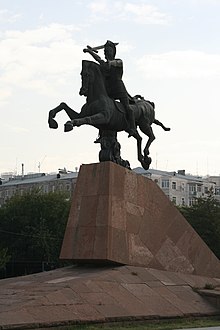Vardan Mamikonjan

Vardan Mamikonjan ( Armenian Վարդան Մամիկոնյան , also: Vardan Mamikonian ; * 387 ; † 451 ) was an Armenian military leader, a martyr and saint of the Armenian Apostolic Church . He became famous for his service as the general of the Armenian army at the Battle of Avarayr 451, in which the decision was ultimately made that the Armenians were allowed to live Christianity.
As a member of the Mamikonjan family of high nobility , he is considered one of the greatest military and spiritual leaders ( Nacharar ) of Armenia and is revered as a national hero. Arshag Chobanian writes: "For the Armenian nation, Vardan (Vartan) is the dearest figure, the holiest of its history, the symbolic hero who typically represents the national spirit." Major Armenian churches are named after Saint Vardan. Equestrian statues of St. Vardan can be found in the Armenian capital Yerevan and in the country's second largest city, Gyumri .
Life
Vardan Mamikonjan was born in 387 in the place Artashat ( Artaxata ) in the Taron region, north of the city of Moosh (Մուշ). His parents were Hamasasp Mamikonjan I. (Համազասպ Մամիկոնյան) and Sahakanusch (Սահականուշ), the daughter of Isaac the Great .
After Vardan was appointed Sparapet (Supreme Commander of the Army) in 432 , the Persians ordered him to Ctesiphon . On his return in 450 Vardan renounced the Persian religion and sparked an Armenian rebellion against the Sassanid occupiers.
Vardan died in the Battle of Avarayr on May 26, 451, where he was trapped on an observation point. Even if the Persians were victorious in the battle, the battle prepared the ground for an agreement between the Persians and the Armenians, which ensured the Christian Armenians religious freedom.
After his death, the uprising continued under the leadership of Vardan's nephew Vahan Mamikonjan , and the Treaty of Nwarsak (484, Նվարսակի պայմանագիր Nwarsaki pajmanagir) gave Armenia an autonomy that ensured the survival of the Armenian state in later centuries.
family
Wardan Mamikonian is the father of Wardeni Mamikonjan ( Shushanik , Շուշանիկ, შუშანიკი, * ~ 409). She married the Varsken (Վազգեն բդեշխ). When her husband, a prominent feudal ruler of the Mihranids ( pitiakhsh , Բդեշխ), approached the Persians again and revoked his Christian faith and accepted Zoroastrianism , he also tried to persuade his wife to convert to religion by force. But she resisted his order and was murdered at his instigation in 475. Like her father, Shushanik was declared a saint ( canonized ) by the Georgian Orthodox Church and is also venerated in the Armenian Apostolic Church . Their feast day is celebrated on October 17th .
Adoration
After his death, Vardan Mamikonjan was canonized as a saint of the Armenian Apostolic Church . He is also venerated as a saint by the Armenian Catholic Church and holds a high standing in the Armenian Evangelical Church .
His feast day in the Armenian Apostolic Church is usually in February and rarely in the first week of March. It is a wandering feast day that is celebrated on Thursdays. There are numerous important Armenian churches named after St. Vardan, including St. Vartan's Cathedral (Սուրբ Վարդան Մայր Տաճար) in New York City . The St. Vartan City Park is also located there .
Vardan or Vartan, Wardan (from the Middle Persian Wardā ), are often given first names for Armenian men, a female version is Vardanoush or Vartanoush, Vardanyan , Vardanian and Vartanian are common Armenian family names.
Individual evidence
- ↑ Grigor A. Sarafian: Battle of Vardanantz and Vardan Mamikonian. (original from the University of California ) Dbaran "Nwor Or", 1950: p. 45.
- ↑ Robert Armot, Alfred Aghajanian: Armenian literature: Comprising poetry, drama, folklore, and classic traditions . Indo-European Pub., Los Angeles, CA 2007, ISBN 9781604440003 , p. 5.
- ↑ Ronald Grigor Suny: Looking toward Ararat Armenia in modern history . Indiana university press, Bloomington 1993, ISBN 9780253207739 , p. 4 .
- ↑ "To the Armenian nation, Vartan [...] is the most beloved figure, the most sacred in their history, the symbolical hero who typifies the national spirit." Archag Tchobanian : The people of Armenia: their past, their culture, their future , G. Marcar Gregory (translator); Viscount Bryce (introduction), Dent, London 1914, pp. 10-11 .
- ↑ Grigor A. Sarafian: Battle of Vardanantz and Vardan Mamikonian (original from the University of California ) Dbaran "Nwor Or", 1950: p. 45.
- ↑ Thea Chkeidze: GEORGIA v. LINGUISTIC CONTACTS WITH IRANIAN LANGUAGES . Retrieved January 6, 2016.
Web links
| personal data | |
|---|---|
| SURNAME | Vardan Mamikonjan |
| ALTERNATIVE NAMES | Վարդան Մամիկոնյան (Armenian); Vardan Mamikonian; Karmirn Vardan; Vartan Mamigonian; Vardan Mamikonean; Kàjn-Vardan; Mamikonian Vardan Hayocʹ Sparapet; Святой Вардан Мамиконян (Russian) |
| BRIEF DESCRIPTION | Armenian prince |
| DATE OF BIRTH | 387 |
| DATE OF DEATH | 451 |
